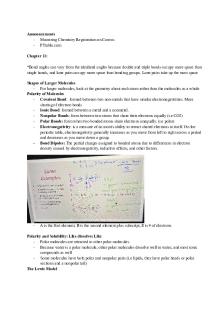Chapter 11: Lewsin Model, Bonds PDF

| Title | Chapter 11: Lewsin Model, Bonds |
|---|---|
| Course | General Chemistry Ii |
| Institution | University of New Hampshire |
| Pages | 2 |
| File Size | 133.1 KB |
| File Type | |
| Total Downloads | 79 |
| Total Views | 151 |
Summary
The Lewis model, bonding and structures and how you make your own Lewis models...
Description
Announcements - Mastering Chemistry Registration on Canvas - PTtable.com Chapter 11: *Bond angles can vary from the idealized angles because double and triple bonds occupy more space than single bonds, and lone pairs occupy more space than bonding groups. Lone pairs take up the most space Shapes of Larger Molecules - For larger molecules, look at the geometry about each atom rather than the molecules as a whole Polarity of Molecules - Covalent Bond: formed between two non-metals that have similar electronegativities. More sharing of electron bonds - Ionic Bond: formed between a metal and a nonmetal. - Nonpolar Bonds: form between two atoms that share their electrons equally (i.e CO2) - Polar Bonds: form when two bonded atoms share electrons unequally. (i.e polar) - Electronegativity: is a measure of an atom's ability to attract shared electrons to itself. On the periodic table, electronegativity generally increases as you move from left to right across a period and decreases as you move down a group. - Bond Dipoles: The partial charges assigned to bonded atoms due to differences in electron density caused by electronegativity, inductive effects, and other factors.
-
A is the first element, B is the second element plus subscript, E is # of electrons
Polarity and Solubility: Like dissolves Like - Polar molecules are attracted to other polar molecules - Because water is a polar molecule, other polar molecules dissolve well in water, and most ionic compounds as well - Some molecules have both polar and nonpolar parts (i.e lipids, they have polar heads or polar sections and a nonpolar tail) The Lewis Model
Pros Cons -
Predicts trends in properties but does not give good numerical predictions, (i.e bond strength and bond length) Gives good first approximations of the bond angles in molecules but usually cannot be used to get the actual angle Cannot write one correct structure for many molecules where resonance is important Often does not predict the correct magnetic behavior of molecules (i.e O2 is paramagnetic, although the lewis structure predicts it is diamagnetic)...
Similar Free PDFs

Chapter 11: Lewsin Model, Bonds
- 2 Pages

Chapter 6 Bonds
- 35 Pages

Ionic Bonds
- 5 Pages

Chapter 7, interest rates and bonds
- 15 Pages

Ch-11 - Chapter 11
- 11 Pages

Bonds Payable
- 12 Pages

Bonds Quiz
- 8 Pages

Chapter 11
- 14 Pages

Chapter 11
- 24 Pages

PB23C - Prize Bonds Form
- 2 Pages
Popular Institutions
- Tinajero National High School - Annex
- Politeknik Caltex Riau
- Yokohama City University
- SGT University
- University of Al-Qadisiyah
- Divine Word College of Vigan
- Techniek College Rotterdam
- Universidade de Santiago
- Universiti Teknologi MARA Cawangan Johor Kampus Pasir Gudang
- Poltekkes Kemenkes Yogyakarta
- Baguio City National High School
- Colegio san marcos
- preparatoria uno
- Centro de Bachillerato Tecnológico Industrial y de Servicios No. 107
- Dalian Maritime University
- Quang Trung Secondary School
- Colegio Tecnológico en Informática
- Corporación Regional de Educación Superior
- Grupo CEDVA
- Dar Al Uloom University
- Centro de Estudios Preuniversitarios de la Universidad Nacional de Ingeniería
- 上智大学
- Aakash International School, Nuna Majara
- San Felipe Neri Catholic School
- Kang Chiao International School - New Taipei City
- Misamis Occidental National High School
- Institución Educativa Escuela Normal Juan Ladrilleros
- Kolehiyo ng Pantukan
- Batanes State College
- Instituto Continental
- Sekolah Menengah Kejuruan Kesehatan Kaltara (Tarakan)
- Colegio de La Inmaculada Concepcion - Cebu





